Introduction
Welcome to this exploration of Advanced SQL – Window Functions Part 1.
SQL is a remarkably rich and versatile declarative database and programming language.
Development of the language started in 1972, first as SQUARE, from 1973 on as SEQUEL (Structured
English Query
Language). In 1977, SEQUEL became SQL because of a
trademark dispute.
Why do we need SQL?
A single-line answer to this question is “Moving Computation Close to the
Data”.
- Let the database system operate over (high-volume) data in native DBMS format
- Fetch the—typically few or even single—result row(s) into the Programming Language heap, perform
lightweight in-heap postprocessing (only if needed)
Let’s take a deep dive together into our first concept in Advanced SQL – Window Functions.
What are window functions?
With SQL:2003, the ISO SQL Standard introduced window functions , a new mode of
row-based
computation:
Input Output
Aggregate functions(sum, avg, count) group of rows → row (one per group)
window function row vicinity → row (one per row)
- Window functions operate on a set of rows ( commonly known as window or frame or row vicinity) and
return a single value for each row. - The term window describes the set of rows on which the function operates.
- A window function uses values from the rows in a window.
Row Vicinity: Window Frames
Windows or frames are the same as the sliding window concept.
Each row is the current row # at one point in time.
Row vicinity (window, frame) is the rows before, after, or both.
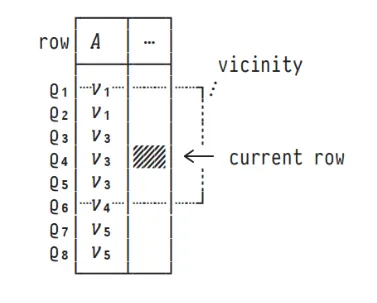
In the above figure, Q4 is the current row and Q1 to Q6 is the frame.
When the current row is Q5, the frame will be Q1 to Q7
As the current row changes, the window slides with it.
NOTE: Window semantics depend on a defined row ordering.
How to define a boundary to a window or frame?
Row vicinity (window, frame) is based on either:
- row position (ROWS windows),
- row valuesᵢ (RANGE windows),
- row peers (GROUPS windows).
Let us see how to define a frame using ROWS, RANGE, and GROUPS frames and their differences
1. ROWS
window_function OVER (ORDER BY A₁,..., Aₙ [ ROWS frame ])
- OVER clause is the indication that the query is a window function.
- ORDER BY clause is mandatory in any window function.
- The data stored in the database is unordered. Window functions are meaningless when operated on unordered
data. - ROWS tag is used to define row-based frame or window
- Frame – frame is the boundary of the window.
Frames examples –
- UNBOUNDED PRECEDING AND CURRENT ROW
- BETWEEN 1 PRECEDING AND 2 FOLLOWING
- BETWEEN CURRENT ROW AND UNBOUNDED FOLLOWING
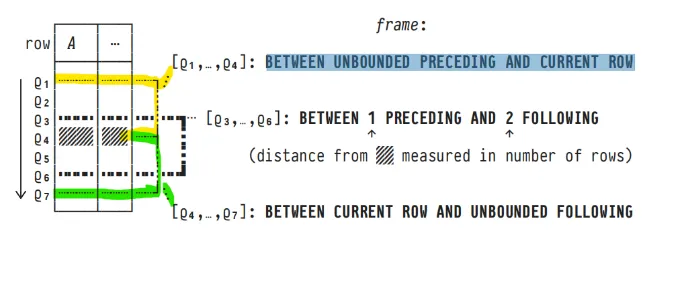
In the above figure, the current row is Q4.
When the frame is defined as BETWEEN UNBOUNDED PRECEDING AND CURRENT
ROW, then the frame is considered from the first record till the current
row.
(highlighted in yellow)
When the frame is defined as BETWEEN 1 PRECEDING AND 2
FOLLOWING,
then the frame is Q3, Q4, Q5, Q6 (highlighted in black)
Q4 – current row
Q3 – 1 preceding
Q5 and Q6 – 2 following
When the frame is defined as BETWEEN CURRENT ROW AND UNBOUNDED
FOLLOWING, then the frame is considered from the current row till the last record
(highlighted
in green)
Time to get our hands dirty
Let us see with an example.
We will create a dummy table with some records and see the ROWS frame in action.
DROP TABLE IF EXISTS sample;
CREATE TABLE sample (
row text PRIMARY KEY,
a int,
b BOOLEAN
);
INSERT INTO sample(row, a, b) VALUES
('Q1', 1, false),
('Q2', 2, true),
('Q3', 3, true),
('Q4', 3, false),
('Q5', 3, true),
('Q6', 4, true),
('Q7', 6, false),
('Q8', 6, false),
('Q9', 7, true);
Query 1 : ROWS frame example
SELECT w.row AS "current row",
w.a,
COUNT(*) OVER win AS "frame size",
array_agg(w.row) OVER win AS "rows in frame"
FROM sample AS w
WINDOW win AS (ORDER BY w.a ROWS BETWEEN UNBOUNDED PRECEDING AND CURRENT ROW);
Working –
From the table sample, all the records are extracted individually and stored in a row variable
“w”.
In the SELECT clause, we are displaying w.row and w.a from the row variable “w”
COUNT(*) OVER win AS "frame size"
This is the same as
COUNT(*) OVER (ORDER
BY
w.a ROWS
BETWEEN UNBOUNDED
PRECEDING AND CURRENT ROW) AS “frame size”
OVER – OVER clause is the indication that
the
subquery is a window function
ORDER BY w.a – All the rows are ordered by “a –
int”
field.
ROWS – The frame window is of type ROWS.
BETWEEN UNBOUNDED PRECEDING AND CURRENT ROW – From the
beginning of
the table to the current row
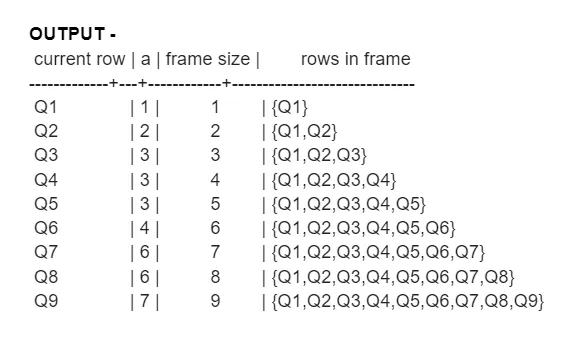
Query 2 : ROWS frame example
SELECT w.row AS "current row",
w.a,
SUM(w.a) OVER win AS "∑ a (so far)"
FROM sample AS w
WINDOW win AS (ORDER BY w.a ROWS BETWEEN UNBOUNDED PRECEDING AND CURRENT ROW);
SUM(w.a) OVER (ORDER BY w.a ROWS BETWEEN UNBOUNDED PRECEDING AND CURRENT ROW) AS "∑ a (so far)
Sum of values from the beginning of the table till the current row.
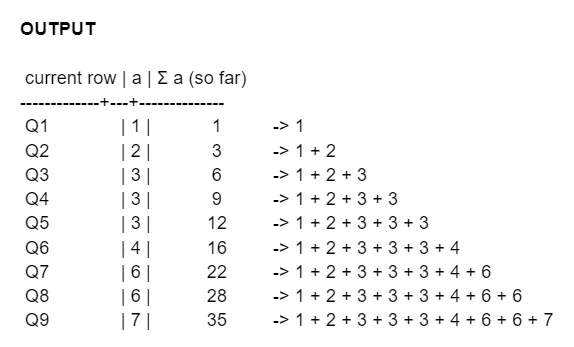
In Django
Create a model same as the table above and fill the records using Admin Panel
class Sample(models.Model):
row = models.CharField(max_length=5)
a = models.PositiveIntegerField()
b = models.BooleanField(default=True)
def __str__(self):
return self.row + "-" + str(self.a) +"-" + str(self.b)
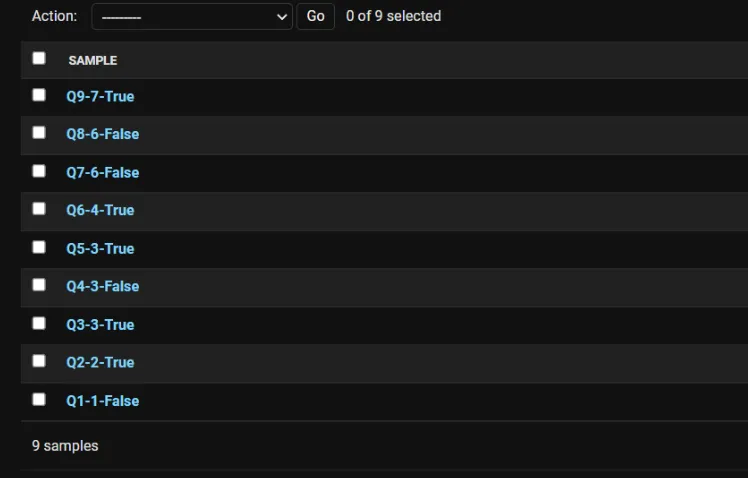
Django Query 1 : ROWS frame example
from .models import Sample
from django.db.models import Avg, F, RowRange, Window, Count
qs = Sample.objects.annotate(
frame_size = Window(
expression=Count('a'),
frame=RowRange(start=None, end=0),
order_by=F('a').asc()
),
)
for i in qs:
print(i.row, i.a, i.b, i.frame_size)
RowRange – This attribute sets the frame_type to ‘ROWS’.
RowRange takes 2 parameters ( start and end)
The accepted values for the start and end arguments are None, an integer, or zero.
A negative integer for start results in N preceding, while None yields UNBOUNDED PRECEDING.
For both start and end, zero will return CURRENT ROW. Positive integers are accepted for the
end.
Start, end
=> 0 – current row
Start
=> -value (-2) – preceding 2
=> None – unbounded preceding
End
=> +value (+2) – following 2
=> None – unbounded following
Each window function should have an expression field that computes to some aggregate
value
Q1 1 False 1
Q2 2 True 2
Q3 3 True 3
Q4 3 False 4
Q5 3 True 5
Q6 4 True 6
Q7 6 False 7
Q8 6 False 8
Q9 7 True 9
Django Query 2 : ROWS frame example
from .models import Sample
from django.db.models import Avg, F, RowRange, Window, Count, Sum
qs = Sample.objects.annotate(
running_sum = Window(
expression=Sum('a'),
frame=RowRange(start=None, end=0),
order_by=F('a').asc()
),
)
for i in qs:
print(i.row, i.a, i.b, i.running_sum)
OUTPUT –
Q1 1 False 1
Q2 2 True 3
Q3 3 True 6
Q4 3 False 9
Q5 3 True 12
Q6 4 True 16
Q7 6 False 22
Q8 6 False 28
Q9 7 True 35
Alternatively, we can create a dictionary to specify window functions and use it as shown in the
example
below.
from .models import Sample
from django.db.models import Avg, F, RowRange, Window, Count, Sum
window = {
'frame': RowRange(start=None, end=0),
'order_by': F('a').asc()
}
qs = Sample.objects.annotate(
running_sum = Window(
expression=Sum('a'), **window
),
frame_size = Window(
expression=Count('a'), **window
),
)
for i in qs:
print(i.row, i.a, i.b, i.frame_size, i.running_sum)
OUTPUT –
Row a b frame_size running sum
Q1 1 False 1 1
Q2 2 True 2 3
Q3 3 True 3 6
Q4 3 False 4 9
Q5 3 True 5 12
Q6 4 True 6 16
Q7 6 False 7 22
Q8 6 False 8 28
Q9 7 True 9 35
2. RANGE and GROUPS
RANGE (row values) –
Similar values are considered as a single unit or peers (1 range).
We don’t operate on a single current row but on a single current peer.
window_function OVER (ORDER BY A₁,...,Aₙ [ RANGE frame ])
Example
row | a | b
—–+—+——-
Q1 | 1 | false
Q2 | 2 | true
Q3 | 3 | true
Q4 | 3 | false
Q5 | 3 | true
Q6 | 4 | true
Q7 | 6 | false
Q8 | 6 | false
Q9 | 7 | true
When the current row is Q3, all its peer values are considered as a single unit.
For Q3, when the frame specification is 2 FOLLOWING – it means the value of ‘a’ less than or equal
to 2.
Q4 => 3-3 = 0
Q5 => 3-3 = 0
Q6 => 4-3 = 1
Q7 => 6-3 = 3
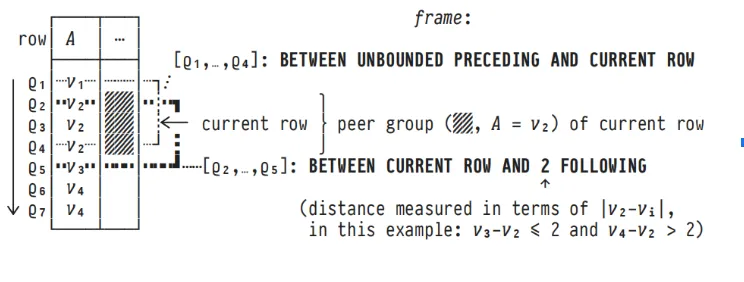
GROUPS (row groups) –
window_function OVER (ORDER BY A₁,...,Aₙ [ GROUPS frame ])
Similar values are considered as a single unit or group. Each group is considered as 1 unit in
window
functions
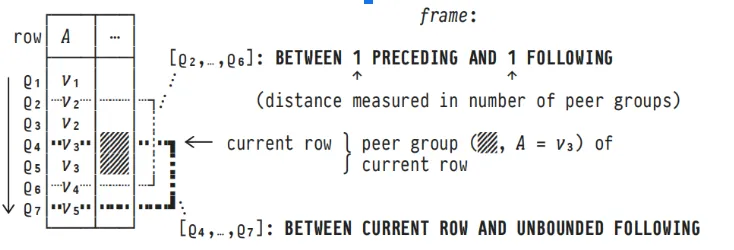
row | a | b
—–+—+——-
Q1 | 1 | false
Q2 | 2 | true
Q3 | 3 | true
Q4 | 3 | false
Q5 | 3 | true
Q6 | 4 | true
Q7 | 6 | false
Q8 | 6 | false
Q9 | 7 | true
Q3, Q4, Q5 have the same ‘a’ value – 3. All these values are considered as a single unit.
Q7, Q8 has the same ‘a’ value – 6. These 2 rows are considered as a single unit.
Example –
Q6 is the current row.
The frame is 1 PRECEDING AND 1 FOLLOWING
1 PRECEDING is 1 group -> Q3, Q4, Q5 (as it is considered as 1 group)
1 FOLLOWING is 1 group -> Q7 and Q8
Query 3 : RANGE frame example
SELECT w.row AS "current row",
w.a,
COUNT(*) OVER win AS "frame size",
array_agg(w.row) OVER win AS "rows in frame"
FROM sample AS w
WINDOW win AS (ORDER BY w.a RANGE BETWEEN CURRENT ROW AND 2 FOLLOWING)
ORDER BY w.a;
OUTPUT –
current row | a | frame size | rows in frame
————-+—+————+——————
Q1 | 1 | 5 | {Q1,Q2,Q3,Q4,Q5}
Q2 | 2 | 5 | {Q2,Q3,Q4,Q5,Q6}
Q3 | 3 | 4 | {Q3,Q4,Q5,Q6}
Q4 | 3 | 4 | {Q3,Q4,Q5,Q6}
Q5 | 3 | 4 | {Q3,Q4,Q5,Q6}
Q6 | 4 | 3 | {Q6,Q7,Q8}
Q7 | 6 | 3 | {Q7,Q8,Q9}
Q8 | 6 | 3 | {Q7,Q8,Q9}
Q9 | 7 | 1 | {Q9}
Explanation –
RANGE BETWEEN CURRENT ROW AND 2 FOLLOWING means the value must be 2 or less than the current
value
Let’s take Q6 as the current row.
Q6 | 4 | 3 | {Q6,Q7,Q8}
Q7 => 6 – 4 = 2
Q8 => 6 – 4 = 2
Q9 => 7 – 4 = 3
Query 4 : GROUPS frame example
SELECT w.row AS "current row",
w.a,
COUNT(*) OVER win AS "frame size",
array_agg(w.row) OVER win AS "rows in frame"
FROM sample AS w
WINDOW win AS (ORDER BY w.a GROUPS BETWEEN CURRENT ROW AND 2 FOLLOWING)
ORDER BY w.a;
OUTPUT –
current row | a | frame size | rows in frame
————-+—+————+———————
Q1 | 1 | 5 | {Q1,Q2,Q3,Q4,Q5}
Q2 | 2 | 5 | {Q2,Q3,Q4,Q5,Q6}
Q3 | 3 | 6 | {Q3,Q4,Q5,Q6,Q7,Q8}
Q4 | 3 | 6 | {Q3,Q4,Q5,Q6,Q7,Q8}
Q5 | 3 | 6 | {Q3,Q4,Q5,Q6,Q7,Q8}
Q6 | 4 | 4 | {Q6,Q7,Q8,Q9}
Q7 | 6 | 3 | {Q7,Q8,Q9}
Q8 | 6 | 3 | {Q7,Q8,Q9}
Q9 | 7 | 1 | {Q9}
Explanation –
Current row – Q6
Window frame – GROUPS BETWEEN CURRENT ROW AND 2 FOLLOWING
Q7, Q8 – 1 FOLLOWING
Q9 – 2 FOLLOWING
Django Query 3 : RANGE frame example
from .models import Sample
from django.db.models import Avg, F, RowRange, Window, Count, ValueRange
qs = Sample.objects.annotate(
frame_size = Window(
expression=Count('a'),
frame=ValueRange(start=0, end=2),
order_by=F('a').asc()
),
)
for i in qs:
print(i.row, i.a, i.b, i.frame_size)
OUTPUT –
Q1 1 False 5
Q2 2 True 5
Q3 3 True 4
Q4 3 False 4
Q5 3 True 4
Q6 4 True 3
Q7 6 False 3
Q8 6 False 3
Q9 7 True 1
ValueRange- This attribute sets the frame_type to ‘RANGE’.
ValueRange takes 2 parameters ( start and end) the same as RowRange.
This is not the end of window functions. There are more interesting and useful functions. To learn
more about
window functions refer to the next part of this blog series.
